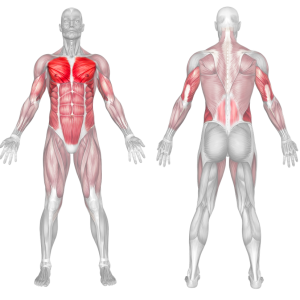Push-up bars Overview
Push-up bars are small, portable handles designed to elevate your hands during push-ups. This elevation allows for a deeper stretch at the bottom of the movement, promoting better muscle engagement while reducing stress on your wrists. By incorporating push-up bars into your routine, you can take your upper body workouts to the next level.
How to Perform Push-Ups with Push-Up Bars

Setup
- Position the Bars
- Place the push-up bars shoulder-width apart on a stable surface. Ensure they are secure and won’t slip.
- Grip the Bars
- Hold the bars firmly with a neutral grip, keeping your wrists straight and aligned with your forearms.
Execution
- Starting Position
- Assume a high plank position with your hands gripping the bars, arms fully extended, and body in a straight line from head to heels.
- Lower Your Body
- Inhale as you bend your elbows, lowering your chest until it’s just below the height of your hands. Keep your elbows at a 45-degree angle to your torso.
- Push Back Up
- Exhale as you press through the bars to return to the starting position.
- Repeat
- Perform 10–15 repetitions for 2–3 sets, maintaining proper form throughout.
Tips for Proper Form
- Engage Your Core: Keep your abs tight to prevent your hips from sagging or lifting.
- Control the Movement: Avoid rushing; focus on a slow, controlled descent and ascent.
- Elbow Position: Keep your elbows at a moderate angle (not flared out) to protect your shoulders.
- Neutral Spine: Maintain a straight line from your head to your heels.
- Breathing: Inhale on the way down, and exhale as you push back up.
Common Mistakes
- Sagging Hips: Dropping your hips can strain your lower back. Keep your core engaged to avoid this.
- Flaring Elbows: Allowing your elbows to flare out excessively can put undue stress on your shoulders.
- Inadequate Range of Motion: Not lowering your chest fully diminishes the exercise’s effectiveness.
- Rushing the Movement: Perform each repetition with control to maximize muscle engagement and reduce the risk of injury.
Benefits of Using Push-Up Bars
- Enhanced Range of Motion
- Push-up bars allow you to lower your chest below your hands, leading to a greater stretch and increased muscle activation.
- Reduced Wrist Strain
- Holding the bars keeps your wrists in a neutral position, minimizing discomfort and risk of injury.
- Improved Stability
- Engages stabilizing muscles, improving balance and overall functional strength.
- Versatility for Variations
- Push-up bars are versatile tools that can be used for standard push-ups, incline push-ups, and more.
- Increased Muscle Activation
- The deeper range of motion and added stability challenges your muscles to work harder.
Muscles Worked

